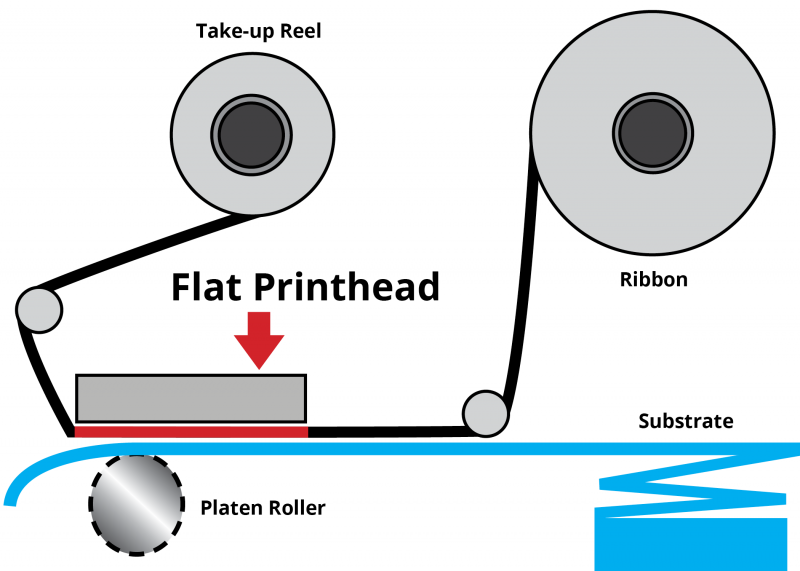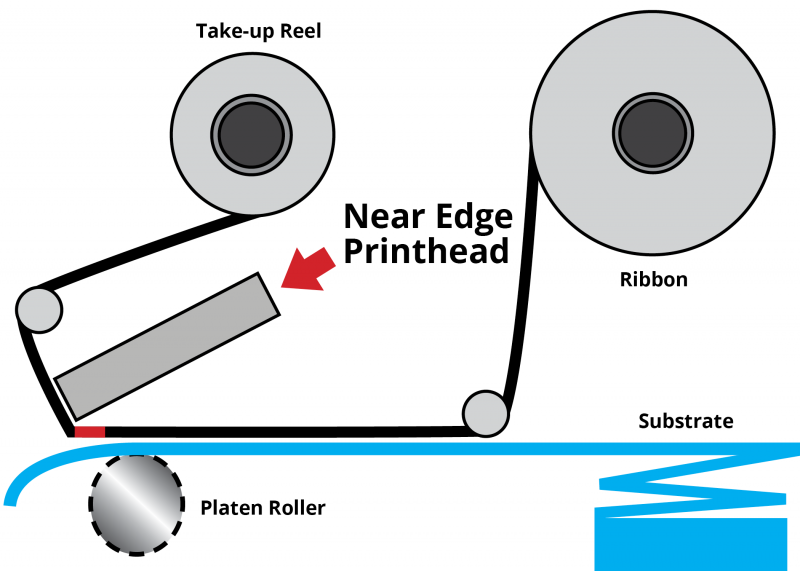Flathead vs. near edge thermal printing
Thermal printing utilizes many components that help produce high-quality images and texts in the labeling and printing industries. The mechanics of these printers operate seamlessly to print barcodes, serial numbers, expiration dates, and more for applications like shipping, tracking, and identification. In this article, we're taking a detailed look at two different types of printer technologies, flathead and near edge printing, and how they’re utilized in thermal transfer printing.
Flathead Thermal Transfer Printing

For flathead thermal printing, the print head is fixed in a horizontal position. It lays flat against the ribbon and media with the heating elements localized in the center of the print head. As the ribbon passes over the heated thermal print head, it transfers ink onto the media.
Both the ribbon and media move together for a short distance after, giving the ink time to cool and solidify. This means that for this type of thermal printing, the substrate and ribbon come into contact with the print head for a longer period of time.
Flathead thermal transfer is the more traditional choice for thermal printing technology, making it more commonly found in printers on the market. Flathead printing operates best in medium volume sized printers, which includes all industrial and most desktop printers.
Flathead printing is able to utilize black ribbons for printing multiple applications on multiple kinds of ribbon material, such as wax, wax/resin, and resin. It is able to be used on paper materials as well as synthetic substrates, like polypropylene, polyester, and vinyl.
Flathead printing supports slower print speeds more easily, around 14ips(inches per second) on average. While it does require less maintenance than near edge printing, users should still be mindful of regular print head maintenance in order to prolong the print quality and print head life. We’ll discuss this more a little later on.
Near Edge Thermal Transfer Printing

While it isn't as common and costs a little more than flathead, near edge printing is still beneficial to thermal printing technology.
With this type of printing, the thermal print head is angled at about 26 degrees, which is often why near edge is referred to as "floating head" or "corner edge" in the printing industry.
The substrate comes into brief contact with the ribbon as it passes under the heated print head, making the transfer of ink onto the substrate instant. Because of this, the distance between where the image is printed and where the ribbon separate from each other is shorter than with flathead printing. The angle also allows the print head to cool down between prints, preventing a continuous rise in temperature, which in turn reduces print head wear.
Near edge printing requires a specific ribbon type in order to print. The ribbon material is limited to wax resin and resin, and must contain a release layer for the ink to quickly detach from the ribbon and transfer onto the substrate. However, this type of thermal printing is able to accommodate colored ribbons besides black, such as white, red, and green.
Products printed with near edge print heads are typically not applied by hand. The printer is set up next to an assembly line, and as the products move along a conveyor belt, the image or text is quickly printed onto the surface area.
Why Use Near Edge Printing?
So if it’s not a standard form of printing, why is near edge printing even used? There are actually several benefits that come from using near edge print heads that make it a great advantage in print production for certain industries and products.
Faster Speeds
Primarily, it is used to achieve fast print speeds while maintaining high quality printing. Printers that utilize near edge print heads can operate at more than double the speeds which are considered fast for other printers, generally between 25-40ips. This also helps to maximize productivity.
Multiple Substrate Materials
Near edge print heads are also able to print on a wide range of substrate materials. With near edgeprinting, because the print head “floats”, it doesn’t require any necessary adjustment for media thickness and automatically calibrates to the substrate being printed. This helps to drastically reduce set-up time and allows for faster and more efficient production.
Minimalistic
Near edge printing operates for the purpose of eliminating waste by using less supplies on a maximum number of products. It is a more efficient way to print on materials that might not hold up to label applications or that require very small fonts to be placed directly on products. Because of the angled thermal print head and the instant transference of ink, near edge stops the ribbon when printing is not needed, ultimately saving ribbon on usage.
Flathead & Near Edge Applications
Since we’ve discussed the details of flathead and near edge printing, it is also important to look at how they are being applied. The mechanisms of each technology offer different advantages and disadvantages to applications.
Flathead Applications
Because it is a standard form of printing, flathead print heads are utilized for most methods of thermal transfer printing. These include printing on paper and non-paper substrates that require a lot of print definition and resolution.
Near Edge Applications
Near edge printing can be found on consumer products. These include items in the food and beverage industry for applications like expiration dates on packages. Soft, flexible material, like plastic and apparel fabrics, are utilized with near edge printing as well.


